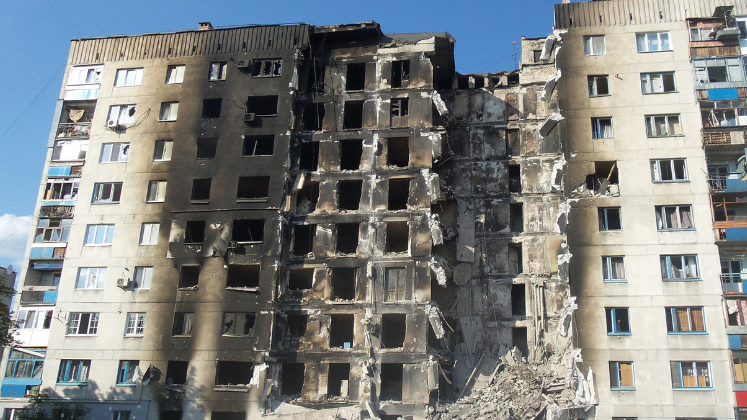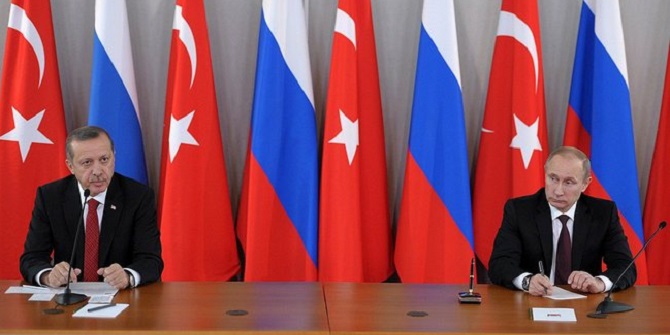In The War in Ukraine’s Donbas: Origins, Contexts, and the Future – available open access– David R. Marples brings together contributors to explore the causes and consequences of the conflict in the Donbas region since 2014. This accessible book offers many observations that will help to deepen understanding of the current war in Ukraine following Russia’s invasion in February 2022, writes Gary Wilson.
The War in Ukraine’s Donbas: Origins, Contexts, and the Future. David R. Marples (eds). CEU Press. 2022.
 For those concerned with international affairs, the ongoing conflict in Ukraine has been the source of much attention following Russia’s invasion in February 2022. However, the current situation in Ukraine only represents the latest incarnation of Russian-Ukrainian tensions, which in recent years might be traced back to Russian interference in Crimea and the Donbas region from 2014 onwards. David R. Marples’s The War in Ukraine’s Donbas therefore represents a contribution to the literature on recent events in Ukraine through its focus on a specific aspect: the course of developments in the Donbas since 2014.
For those concerned with international affairs, the ongoing conflict in Ukraine has been the source of much attention following Russia’s invasion in February 2022. However, the current situation in Ukraine only represents the latest incarnation of Russian-Ukrainian tensions, which in recent years might be traced back to Russian interference in Crimea and the Donbas region from 2014 onwards. David R. Marples’s The War in Ukraine’s Donbas therefore represents a contribution to the literature on recent events in Ukraine through its focus on a specific aspect: the course of developments in the Donbas since 2014.
The War in Ukraine’s Donbas takes the form of an edited collection that seeks to make sense of the causes and consequences of conflict in the Donbas. The approach is multidisciplinary, with the contributors including international lawyers, historians and political scientists. The perspectives touch upon issues that are broad – for example, understanding the background to conflict in the Donbas and the key motivations for participation in hostilities on both sides – and narrow – such as the role of volunteers in repatriation of the war dead or the significance of the Sea of Azov to both sides.
The book comprises ten substantive chapters in addition to the introduction, which details the conference from which it was conceived. In the first chapter, William Jay Risch considers the background to conflict in the Donbas. He notes that the Euromaidan protests that swept Ukraine in 2014 were relatively small in the Donbas, while the region also demonstrated both opposition to proposals for Ukraine to apply for membership of the European Union (EU) and support for the ousted Russia-backed Ukrainian President Viktor Yanyukovych. These positions placed the Donbas at odds with the general sentiment in Ukraine.

Image Credit: Crop of ‘Apartment building destroyed during War in Donbass. Lysychansk, Lugansk region’ 2014 by Ліонкінг licensed under CC BY SA 4.0
In Alina Cherviatsova’s chapter, the focus is on the Minsk agreements that sought to bring a conclusion to hostilities within the Donbas. While noting the scale of international condemnation of Russian aggression in the region by bodies including the United Nations, the Council of Europe, the Organization for Security and Co-operation in Europe (OSCE) and the EU, Cherviatsova observes that the Minsk agreements represented the only formal documents entered into by both Russia and Ukraine with a view to ending the conflict. Although set against a context of blended political and legal rhetoric, neither side has yet acted upon its commitments under Minsk.
The chapters by Kimitaka Matsuzato, Oksana Mikheieva and Natalia Stepaniuk are all concerned with aspects of the wider dynamics of the conduct of the conflict in the Donbas. Matsuzato explores the means used by Russia to exert influence over the region and details the use of so-called ‘political technologists’ to convey Russia’s diktats to sympathetic actors. Labelling these as ‘low quality’, he proceeds to suggest that over the course of four years the Novorussian movement – the term given to the Russian public movement supporting Ukrainian rebels – has lost its social revolutionary characteristics, becoming simply an anti-Western geopolitical project.
Mikheieva focuses upon the motivations of both pro-Russian and pro-Ukrainian combatants, identifying some significant differences, national identity being the most marked. At the same time, Ukrainians were far more likely to have attended higher education and enjoyed stronger group identities and social mobility levels. The chapter by Stepaniuk is concerned with the role of volunteer networks in the conflict. Taking note of the Ukrainian Army’s limited military capacity, Stepaniuk illustrates the emergence of groups led by volunteers in support of combatants: for example, affording assistance to war veterans and in the provision of healthcare services.
The book’s later chapters tackle a series of more specific issues arising from or pertinent to the conflict in the Donbas. While the surge in population movement caused by the conflict post-2014 pales in comparison with the numbers of refugees fleeing Ukraine as a whole during 2022, the earlier scale of internally displaced persons produced from the Donbas conflict was no minor crisis itself, as Ernest Gyidel’s chapter highlights. Up to two million people were driven out of the region as a result of the hostilities, resulting in the creation of dedicated NGOs to provide support.
Oleksandr Melynk considers the challenges that have arisen from efforts to repatriate casualties of the conflict in the Donbas. The role of ‘memorial societies’ in forming search teams to locate and repatriate the remains of the war dead, and to facilitate prisoner-of-war exchanges, is detailed, with reference to the testimony of participants. These groups have enjoyed relative success, having been involved in the return of over 800 individuals, their volunteer status being judged central to their effectiveness.
Developments in respect of the Sea of Azov, a strategically important location for both Russia and Ukraine, are the focus of the chapter by Alla Hurska. The Sea of Azov has been the source of numerous disputes since the collapse of the Soviet Union, which changed its status from that of internal waters to an international body of water. Russia has assumed de facto control since the annexation of Crimea, while a ruling against it by the International Tribunal on the Law of the Sea following its seizure of Ukrainian vessels has not led to a change in its course of action. Russia’s intervention in the Donbas has relied heavily upon its use of unofficial groups, the focus of Sergey Sukhankin’s chapter on private military contractors. Their employment by Russia has increased considerably since 2013, with the Donbas considered the main testing ground for their use.
In the book’s final chapter, Serhiy Kudelia considers the prospects for resolution of the conflict in the Donbas. Five main ‘incompatibilities’ are identified, however, which have undermined progress. In short, these essentially boil down to differences between the Donbas and Ukraine at large concerning how Ukraine ought to be governed, its future relationships with organisations like the EU and NATO and its political proximity to Russia. Potential solutions include consideration of power measures and greater regional autonomy, although the importance of disarmament and transitional justice mechanisms as necessary steps towards progress is also noted.
Overall, this book offers food for thought on a number of important issues relevant to understanding developments in the Donbas and their wider consequences. It is eminently accessible in a way which will make it of interest to more general readers as well as scholars and students of international relations, law and history. Although focused upon the Donbas region in the period prior to the start of the much greater conflict in Ukraine as a whole in 2022, many of the observations carry wider relevance in making sense of the current war.
- This review first appeared at LSE Review of Books.
Please read our comments policy before commenting.
Note: This article gives the views of the author, and not the position of USAPP – American Politics and Policy, nor of the London School of Economics.
Shortened URL for this post: https://bit.ly/3bL8AS1
About the reviewer
Gary Wilson – Liverpool John Moores University
Dr Gary Wilson, Phd LLB (Hons.), FHEA is Senior Lecturer in Law at Liverpool John Moores University. He specialises in collective security, the use of force and issues of secession and self-determination.






